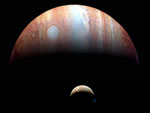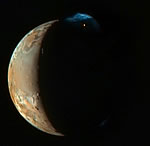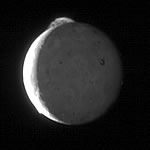
:: Jupiter ::
Jupiter is the 4th planet from the Sun. It is named after the supreme god in Roman mythology. He was the god of the sky, heavens and law.
Jupiter is the largest planet in our solar system by a long way. If you were to combine all of the other planets in our solar system together Jupiter would still be over two and a half times bigger!
Jupiter is mainly composed of Hydogen and Helium, the same as the Sun. In fact, if Jupiter had formed 80 times bigger that what it is now it would have become a star rather than a planet.
Jupiter has 4 main moons, Io, Europa, Ganymede and Callisto. Collectively these 4 moons are called the Galilean satellites after the astronomer, Galileo Galilei who first discovered them in the year 1610.
At last count Jupiter has a total of 62 moons although only 49 have been officially named so far.
|
1. Io 2. Europa 3. Ganymede 4. Callisto 5. Amalthea 6. Himalia 7. Elara 8. Pasiphae 9. Sinope 10. Lysithea 11. Carme 12. Ananke 13. Leda 14. Thebe 15. Adrastea 16. Metis 17. Callirrhoe 18. Themisto 19. Megaclite 20. Taygete 21. Chaldene |
22. Harpalyke 23. Kalyke 24. Iocaste 25. Erinome 26. Isonoe 27. Praxidike 28. Autonoe 29. Thyone 30. Hermippe 31. Aitne 32. Eurydome 33. Euanthe 34. Euporie 35. Orthosie 36. Sponde 37. Kale 38. Pasithee 39. Hegemone 40. Mneme 41. Aoede 42. Thelxinoe |
43. Arche 44. Kallichore 45. Helike 46. Carpo 47. Eukelade 48. Cyllene 49. Kore 50. S/2003 J2 51. S/2003 J3 52. S/2003 J4 53. S/2003 J5 54. S/2003 J9 55. S/2003 J10 56. S/2003 J12 57. S/2003 J15 58. S/2003 J16 59. S/2003 J17 60. S/2003 J18 61. S/2003 J19 62. S/2003 J23 |
Images of Jupiter from Voyager 1
Images of Jupiter from the New Horizons space craft that is on its way to Pluto.
 Credit: NASA, Johns Hopkins U. APL, SWRI |
 Credit: (NASA, JHU/APL, SwRI - Additional Processing: Sean Walker) |
 Credit: NASA / JHUAPL / SwRI |
| In February 2007, New Horizons passed Jupiter and one of its moons Io. As it passed, these amazing pictures were taken. The picture of Io was taken separately and digitally impossed over Jupiter. On Io you can clearly see a plume coming from the volcano Tvashtar. | Click on this image to see an amazing animation of the Io volcano Tvashtar erupting. You can see lava spraying 330 kilometers up and then falling back down again to the Ionian surface. The animation is made up of five images taken over a period of eight minutes beginning at 23:50 UT on March 1, 2007. |
:: Facts ::
Jupiter is the 5th planet from the Sun.
Jupiter was named after the King of the Roman gods.
Diameter: 142,984 km, 11 times the diameter of the Earth
You could fit 1300 earth's within Jupiter
Mass: Jupiter's mass is 318 times greater than the Earth's
Day Length: 10 Earth hours
Year Length: 11 Years, 315 Days, 1.1 Hours
Average Distance from Sun: 483.6 million miles
Temperatures vary from -163°C to greater than -121°C.
Atmosphere: Jupiter's atmoshere is mostly made up of Hydrogen, Helium.
Jupiter has 4 large moons, Io, Europa, Ganyede and Callisto. It also has another 56 minor moons which are usually no more than 4km across.